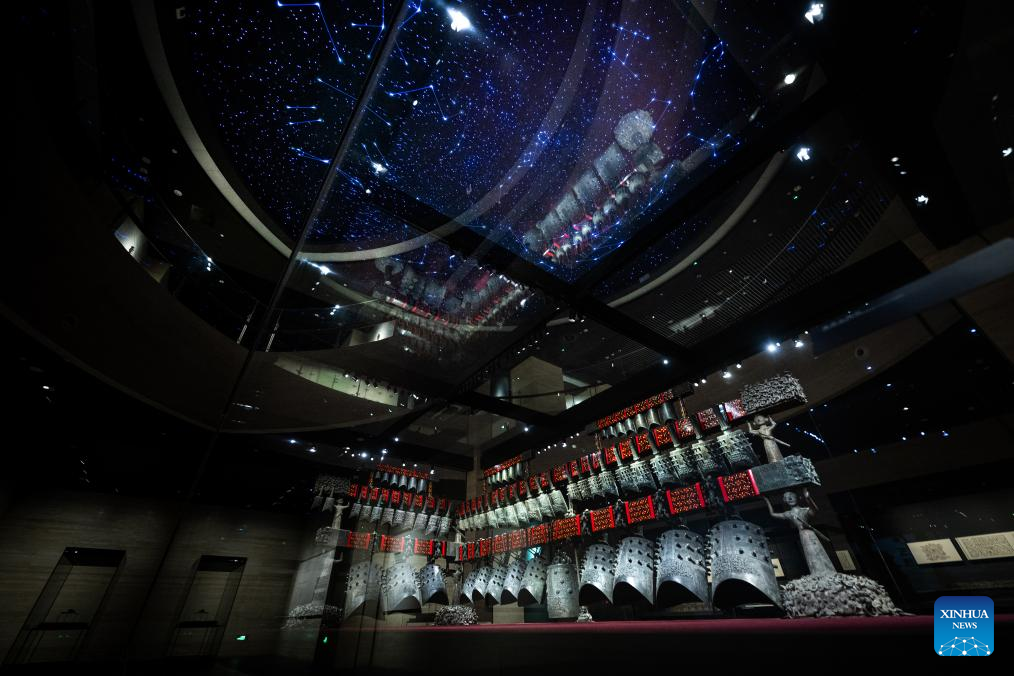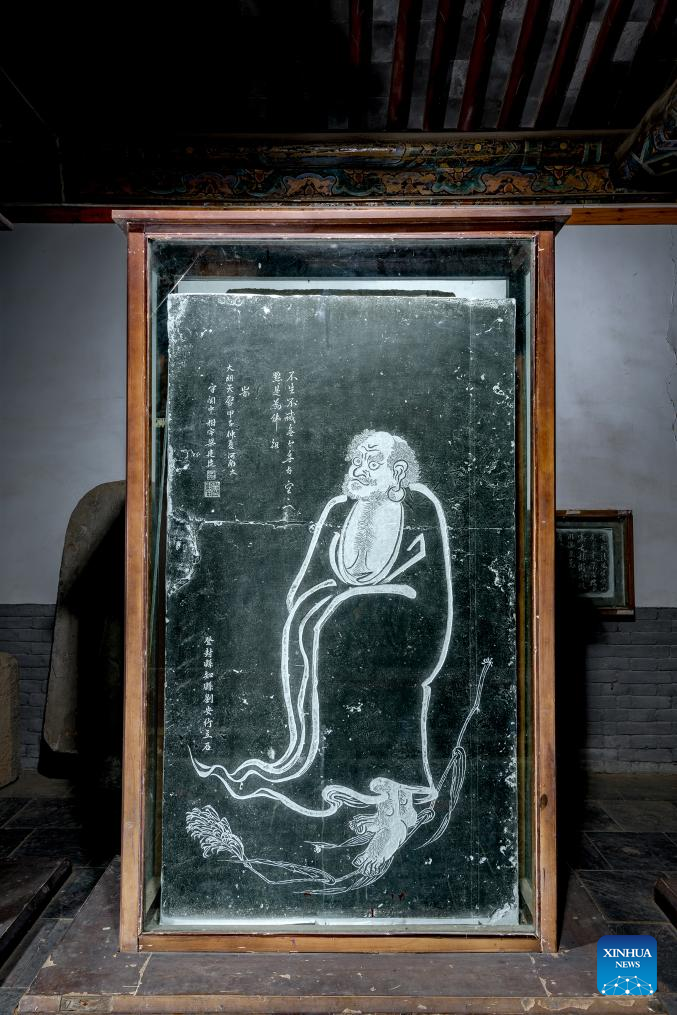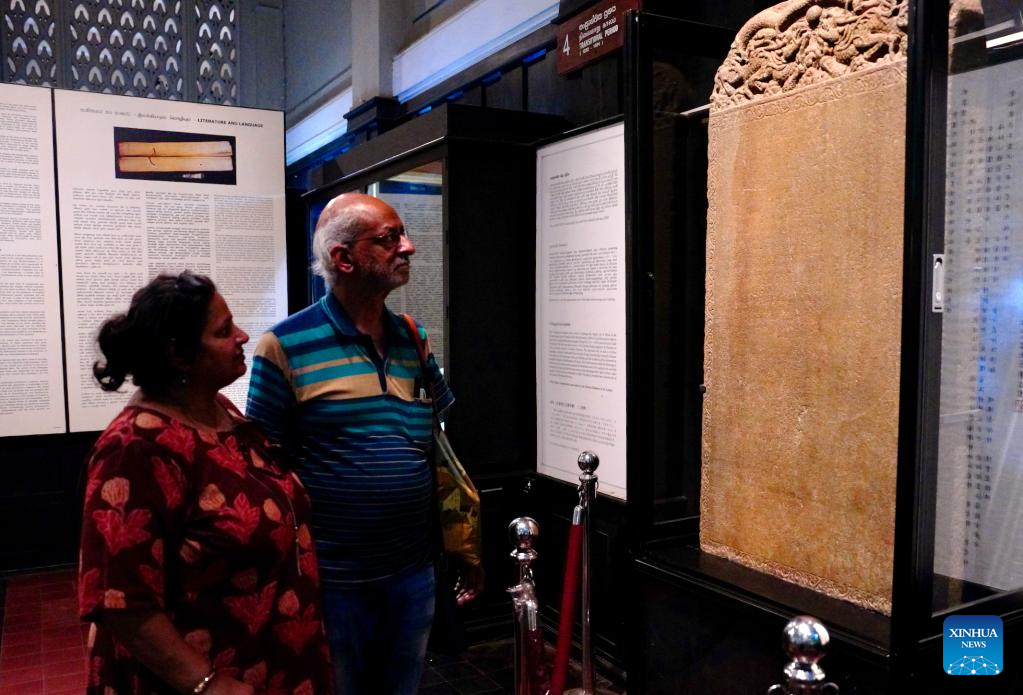China reinforces documentary heritage protection with new UNESCO designations
From:XinhuaAuthor: 2025-04-18 09:32

The Bianzhong of Marquis Yi of Zeng is pictured in Hubei Provincial Museum in Wuhan, central China's Hubei Province, April 17, 2025. Three documentary heritage collections submitted by China have been inscribed in the UNESCO Memory of the World Register, the United Nations Educational, Scientific and Cultural Organization announced on Thursday. Among the 74 newly added entries, China contributed two solo submissions - the Bianzhong of Marquis Yi of Zeng and the Steles of Shaolin Temple - as well as a joint submission with Sri Lanka: the Trilingual Inscription. (Xinhua/Xiao Yijiu)
China has shown the world its unrelenting commitment to protecting humanity's shared cultural legacy with three new documentary heritage items added to the Memory of the World (MoW) Register of the United Nations Educational, Scientific and Cultural Organization (UNESCO) on Thursday.
With the latest additions -- the Bianzhong of Marquis Yi of Zeng, the Steles of Shaolin Temple (566-1990) and Trilingual Inscription (TribhashaSellipiya) -- China now has 18 entries in the international register, which was launched by UNESCO in 1992 to facilitate preservation of the world's documentary heritage, enable universal access to documentary heritage worldwide and enhance public awareness.
Dubbed the world's first "sound-producing music textbook," the Bianzhong of Marquis Yi of Zeng, dating back more than 2,400 years, is currently on display at the Hubei Provincial Museum in central China. The bronze percussion instrument weighs nearly 5 tonnes, and comprises 65 bianzhong, or chime bells.
The bells, which are arranged across three tiers and eight groupings at the exhibition, featured 3,755 inscribed Chinese characters -- the only known systematic musical treatise from the 5th century B.C.
In 2024, the museum reported more than 5 million visits. During peak periods, daily visits to the bianzhong exhibition exceeded 30,000 people, said Zhang Xiaoyun, curator of the museum.
To better preserve such documentary heritage, in 1984, the museum commissioned a full set of replicated chime bells to be used for performances and research, allowing the ancient instrument to resonate beyond museum walls. Three years later, the museum established a bianzhong performance troupe, with its members having performed to over 10 million live spectators worldwide.
For more than 40 years, specialists in archaeology, metallurgy, acoustics, astronomy, ancient writing, chemistry, music and other fields from across the globe have researched the chime bells and their inscriptions.
UNESCO's recognition is also reflected through the continuous conservation work at the Shaolin Temple in the central Henan Province, where 499 ancient steles chronicle the extensive exchanges and interactions between the temple -- the birthplace of kung fu -- and ancient officials, celebrities, overseas Buddhists and secular society between 556 and 1990.
The steles distributed at the temple and its surrounding areas are protected according to each monument's condition and location. "We have installed glass cases around fragile inscriptions or protective railings around exposed pieces," said Yang Hongrui, the temple's chief archivist.
According to Yang, the temple has collaborated with institutions to digitally archive the entire collection and establish a digital archives exhibition hall.
"During its trial operation last September, the digital archives exhibition hall, spanning approximately 100 square meters, drew overwhelming crowds, averaging 14 visitors per minute with some staying for up to two to three hours," Yang said.
Yang added that to celebrate its inclusion in the MoW Register, the hall will officially open to the public ahead of May, and there are plans for international touring exhibitions of these archival treasures at the temple's 168 overseas cultural centers.
Similar to the Shaolin steles, Trilingual Inscription (TribhashaSellipiya), jointly submitted by China and Sri Lanka, also provides evidence of China's interactions with other civilizations.
The monument, brought to Sri Lanka over 600 years ago by renowned Chinese navigator Zheng He during his third voyage, is held by the national museum in Colombo as one of the most precious collections. It is a testament to cultural exchanges between China and the outside world, as inscriptions written in Chinese, Persian and Tamil recorded ceremonial offerings to a sacred mountain shrine by Zheng's fleet.
"The joint efforts underscore the mutual respect and commitment to cultural preservation that Sri Lanka and China have cultivated over the years. Such recognition will undoubtedly encourage further collaborations in fields such as archaeology, education and tourism," Ruwan Ranasinghe, Sri Lanka's deputy minister of Foreign Affairs, Foreign Employment and Tourism, told Xinhua.
China made its first application to the MoW Register in 1997, establishing itself as one of the earliest participants and the first nation to create a dedicated national committee for the program.
"The inclusion in the MoW Register underscores the remarkable richness of Chinese archival heritage. This designation highlights the nation's wealth of documentary resources worthy of preservation," said professor Chen Shaofeng from Peking University. He noted that authorities can focus on more ethnic minority documents for future UNESCO nominations.
To date, China has officially recognized 198 items or groups of archival heritage at the national level. The National Archives Administration of China has further urged provincial-level archives authorities to develop regional catalogues to expand and refine the global memory preservation framework.

This undated file photo shows a stele in Shaolin Temple in Dengfeng City, central China's Henan Province. Three documentary heritage collections submitted by China have been inscribed in the UNESCO Memory of the World Register, the United Nations Educational, Scientific and Cultural Organization announced on Thursday. Among the 74 newly added entries, China contributed two solo submissions - the Bianzhong of Marquis Yi of Zeng and the Steles of Shaolin Temple - as well as a joint submission with Sri Lanka: the Trilingual Inscription. (Xinhua)
?
Visitors look at the Trilingual Inscription at the Colombo National Museum in Colombo, Sri Lanka, April 17, 2025. Three documentary heritage collections submitted by China have been inscribed in the UNESCO Memory of the World Register, the United Nations Educational, Scientific and Cultural Organization announced on Thursday. Among the 74 newly added entries, China contributed two solo submissions - the Bianzhong of Marquis Yi of Zeng and the Steles of Shaolin Temple - as well as a joint submission with Sri Lanka: the Trilingual Inscription. (Xinhua/Wu Yue)
Edit:董麗娜
The copyright of the article and the picture belongs to the original author. If there is any infringement, please contact to delete it